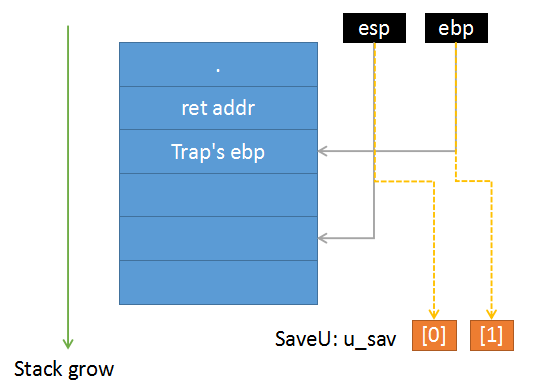In this part, we focus on the relationship between signal and system call.
0x01 Basic Knowledge
Variables related to signal
/* Current signal -- index of u_signal */
int Process::p_sig;
/* Signal handler table */
unsigned long User::u_signal[NSIG];
/* Whether signal interrupts system call: 1 yes - 0 no */
bool User::u_intflg;
/* To jump back to Trap() from Sleep(), signal received */
unsigned long User::u_qsav[2]
For u_signal we should know:
- If
u_signal[p_sig]is 0, then exit itself - If
u_signal[p_sig]is odd, then ignore this signal - If
u_signal[p_sig]is even, then it is handler address
Methods related to signal
- Send signal to current process
void Process::PSignal(int signal)
{
if ( signal >= User::NSIG ) // no more space
return;
if ( this->p_sig != User::SIGKILL )
this->p_sig = signal;
if ( this->p_pri > ProcessManager::PUSER )
this->p_pri = ProcessManager::PUSER;
if ( this->p_stat == Process::SWAIT ) // wake it
this->SetRun();
}
- Handle signal received
void Process:PSig(struct pt_context *pContext)
{
User& u = Kernel::Instance().GetUser();
int signal = this->p_sig;
this->p_sig = 0;
if ( u.u_signal[signal] != 0 )
{
u.u_error = User::NOERROR;
unsigned int old_eip = pContext->eip;
pContext->eip = u.u_signal[signal];
pContext->esp -= 4;
int* pInt = (int *)pContext->esp;
*pInt = old_eip;
u.u_signal[signal] = 0;
return;
}
u.u_procp->Exit();
}
- Set user’s signal handler
void Process::Ssig()
{
User& u = Kernel::Instance().GetUser();
int signalIndex = u.u_arg[0];
unsigned long func = u.u_arg[1];
if ( signalIndex <= 0 || signalIndex >= User::NSIG || signalIndex == User::SIGKILL )
u.u_error = User::EINVAL;
return;
}
u.u_ar0[User::EAX] = u.u_signal[signalIndex];
u.u_signal[signalIndex] = func;
if ( u.u_procp->p_sig == signalIndex )
u.u_procp->p_sig = 0;
}
- Check whether signal is received
int Process::IsSig()
{
User& u = Kernel::Instance().GetUser();
if ( this->p_sig == 0 )
return 0;
else if ((u.u_signal[this->p_sig] & 1) == 0)
return this->p_sig;
return 0;
}
0x02 Dive into System Call
We will go in logic order. The number in each sub-title below is used to show function layers relationship.
To obtain an integratal view, we will take two examples with different sleep priorities and different responses to signal as a result:
SystemCall::Sys_ReadSystemCall::Sys_Wait
0 Into SystemCall::SystemCallEntrance
SaveContext();
SwitchToKernel();
CallHandler(SystemCall, Trap);
Save almost all the registers.
Then switch to kernel mode.
Finally call SystemCall’s Trap.
1 Into SystemCall::Trap
If process receives signal then response:
if ( u.u_procp->IsSig() )
{
u.u_procp->PSig(context);
u.u_error = User::EINTR;
regs->eax = -u.u_error;
return;
}
Then it calls Trap1 to deal with signal:
Trap1(callp->call);
2 Into SystemCall::Trap1
Set u_intflg to 1, assuming that the system call will be interrupted by signal.
u.u_intflg = 1;
Then save esp and ebp to u_qsav:
SaveU(u.u_qsav);

Then call the handler function:
func();
Firstly, let’s explore SystemCall::Sys_Read.
3 Into SystemCall::Sys_Read
fileMgr.Read();
4 Into FileManager::Read
this->Rdwr(File::FREAD);
5 Into FileManager::Rdwr
pFile->f_inode->ReadI();
6 Into Inode::ReadI
pBuf = bufMgr.Bread(dev, bn);
7 Into BufferManager::Bread
this->IOWait(bp);
8 Into BufferManager::IOWait
u.u_procp->Sleep((unsigned long)bp, ProcessManager::PRIBIO);
Note that priority number < 0 means high priority sleep, and priority number > 0 means low. Here it is PRIBIO = -50, so this is high priority sleep.
9 Into Process::Sleep
else // high priority sleep
{
X86Assembly::CLI();
this->p_wchan = chan;
this->p_stat = Process::SSLEEP;
this->p_pri = pri;
X86Assembly::STI();
Kernel::Instance().GetProcessManager().Swtch();
}
You can see that high priority sleep will not be interrupted by signal.
Now it’s time to go back.
8 Back to BufferManager::IOWait
7 Back to BufferManger::Bread
6 Back to Inode::ReadI
5 Back to FileManager::Rdwr
4 Back to FileManager::Read
3 Back to SystemCall::Sys_Read
2 Back to SystemCall::Trap1
Remember that we set u_intflg to 1 before? If logic stream goes here, it means the system call finished successfully. So we should reset this flag variable.
u.u_intflg = 0;
1 Back to SystemCall::Trap
if ( u.u_intflg != 0 )
u.u_error = User::EINTR;
Here u.u_intflg is 0.
Then
if( User::NOERROR != u.u_error ){
regs->eax = -u.u_error;
Diagnose::Write("regs->eax = %d , u.u_error = %d\n",regs->eax,u.u_error);
}
At the end of Trap, it will check signal again:
if ( u.u_procp->IsSig() )
u.u_procp->PSig(context);
0 Back to SystemCall::SystemCallEntrance
At last, the entrance method will do some process schedule operation, which has little thing to do with signal:
struct pt_context *context;
__asm__ __volatile__ (" movl %%ebp, %0; addl $0x4, %0 " : "+m" (context) );
if( context->xcs & USER_MODE ){
while(true){
X86Assembly::CLI();
if(Kernel::Instance().GetProcessManager().RunRun > 0){
X86Assembly::STI();
Kernel::Instance().GetProcessManager().Swtch();
}
else
break;
}
}
RestoreContext();
Leave();
InterruptReturn();
Second, let’s explore SystemCall::Sys_Wait. We will directly go from function layer 3.
3 Into SystemCall::Sys_Wait
procMgr.Wait();
4 Into ProcessManager::Wait
if (true == hasChild)
{
u.u_procp->Sleep((unsigned long)u.u_procp, ProcessManager::PWAIT);
continue;
}
Note that PWAIT is 40 > 0, so this is a low priority sleep.
5 Into Process:Sleep
if ( pri > 0 ) // low priority
{
if ( this->IsSig() )
{
aRetU(u.u_qsav);
return;
}

This is the difference from high priority sleep. This Sleep will directly skip to Trap1’s stack frame and then return immediately if signal received.
Code below is to switch to another process.
X86Assembly::CLI();
this->p_wchan = chan;
this->p_stat = Process::SWAIT;
this->p_pri = pri;
X86Assembly::STI();
if ( procMgr.RunIn != 0 )
{
procMgr.RunIn = 0;
procMgr.WakeUpAll((unsigned long)&procMgr.RunIn);
}
Kernel::Instance().GetProcessManager().Swtch();
After waking up, check signal immediately and return Trap if signal received.
if ( this->IsSig() )
{
aRetU(u.u_qsav);
return;
}
If return to Trap directly:
1 | Back to SystemCall::Trap
if ( u.u_intflg != 0 )
u.u_error = User::EINTR;
Because Trap1 is skipped, so u.u_intflg is 1.
If no signal received during system call:
4 Back to ProcessManager::Wait 3 Back to SystemCall::Sys_Wait
And then back to 2,1 as the description of Sys_Read.